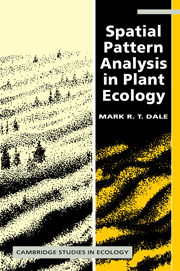Book contents
- Frontmatter
- Contents
- Preface
- 1 Concepts of spatial pattern
- 2 Sampling
- 3 Basic methods for one dimension and one species
- 4 Spatial pattern of two species
- 5 Multispecies pattern
- 6 Two-dimensional analysis of spatial pattern
- 7 Point patterns
- 8 Pattern on an environmental gradient
- 9 Conclusions and future directions
- Bibliography
- Glossary of abbreviations
- List of plant species
- Index
6 - Two-dimensional analysis of spatial pattern
Published online by Cambridge University Press: 04 December 2009
- Frontmatter
- Contents
- Preface
- 1 Concepts of spatial pattern
- 2 Sampling
- 3 Basic methods for one dimension and one species
- 4 Spatial pattern of two species
- 5 Multispecies pattern
- 6 Two-dimensional analysis of spatial pattern
- 7 Point patterns
- 8 Pattern on an environmental gradient
- 9 Conclusions and future directions
- Bibliography
- Glossary of abbreviations
- List of plant species
- Index
Summary
Introduction
The preceding three chapters have examined various aspects of the study of spatial pattern in one dimension using data acquired by several sampling methods including strings of contiguous quadrats. In fact, we know that in real vegetation, spatial pattern exists in at least two, if not three, dimensions. We know, also, that spatial pattern may be anisotropic, exhibiting different characteristics in different directions. Depending on the application, we may want to retain that anisotropy in the analysis, or we may want to average over all possible directions to look at the overall spatial pattern.
There are several approaches to two-dimensional analysis available, most of which are adaptations of methods initially developed for one-dimensional analysis. It is interesting that one of the earliest methods, blocked quadrat variance (BQV), was originally proposed in a two-dimensional version (Greig-Smith 1952), for the analysis of spatial pattern in grids of quadrats.
The practical problem associated with two-dimensional analysis is the collection of data. Studies of pattern in one dimension have usually sampled the vegetation with strings of small contiguous square quadrats from as few as 36 (Usher 1983) to 1001 (Dale and Zbigniewicz 1995). The amount of work necessary for one-dimensional studies is often great, and to extend them into two dimensions would, in many instances, be impractical. Most of the two-dimensional analysis methods described here may be most useful when applied to data collected by means such as the digitizing of images or the direct acquisition of digital images.
- Type
- Chapter
- Information
- Spatial Pattern Analysis in Plant Ecology , pp. 168 - 205Publisher: Cambridge University PressPrint publication year: 1999



